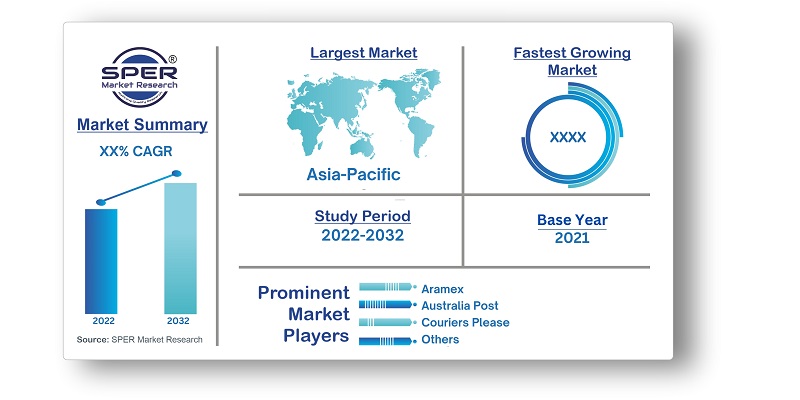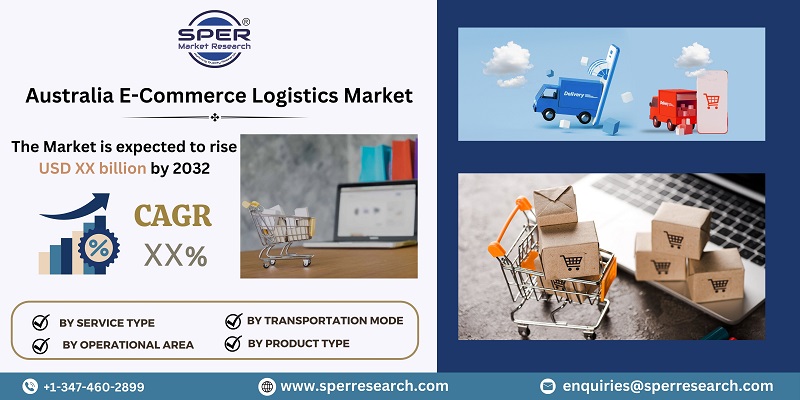
Australia E-Commerce Logistics Market Growth, Share, Size, Revenue, Challenges and Future Trends
Australia E-Commerce Logistics Market Size- By Service Type, By Operational Area, By Transportation Mode, By Product Type- Regional Outlook, Competitive Strategies and Segment Forecast to 2032
| Published: Mar-2023 | Report ID: AMIN2371 | Pages: 1 - 108 | Formats*: |
| Category : Automotive & Transportation | |||
- Augmenting Use of EVs for Transportation: Logistics companies in Australia are increasingly adopting electric vehicle (EV) solutions through strategic partnerships and distribution agreements. This move allows them to reduce carbon emissions and lower operational expenses. Bolloré Logistics Australia and Primary Connect, in collaboration with Linfox Logistics, are among the players that have embraced the use of EV trucks for transporting goods in Australia. By utilizing EVs, these companies aim to minimize their carbon footprints and achieve cost savings in their operations.


| Report Metric | Details |
| Market size available for years | 2019-2032 |
| Base year considered | 2021 |
| Forecast period | 2022-2032 |
| Segments covered | By Service Type, By Operational Area, By Transportation Mode, By Product Type |
| Regions covered | Western Australia, New South Wales, Queensland, Northern territory, South Australia, Victoria, Tasmania |
| Companies Covered | Aramex, Australia Post, Couriers Please, DB Schenker, DHL, DTDC, E-store logistics, FedEx, Linfox, Mainfreight, StarTrack, Toll group, UPS |
- E – Retailers
- E-commerce Companies
- Integrates Logistics Companies
- Logistics/Supply Chain Industry Associations
- Potential Market Entrants
- Third Party Logistics Companies
- Others
| By Service Type: |
|
| By Operational Area: |
|
| By Transportation Mode: |
|
| By Product Type: |
|
- Australia E-Commerce Logistics Market Size (FY’2022-FY’2032)
- Overview of Australia E-Commerce Logistics Market
- Segmentation of Australia E-Commerce Logistics Market By Service Type (Warehousing, Transportation, Other Service)
- Segmentation of Australia E-Commerce Logistics Market By Operational Area (International, Domestics)
- Segmentation of Australia E-Commerce Logistics Market By Transportation Mode (Air, Rail, Road, Sea)
- Segmentation of Australia E-Commerce Logistics Market By Product Type (Apparel and Accessories, Auto and Parts, Baby Products, Books, Electronics, Health, Personal Care and Beauty, Home Furnishing Products, Others)
- Statistical Snap of Australia E-Commerce Logistics Market
- Expansion Analysis of Australia E-Commerce Logistics Market
- Problems and Obstacles in Australia E-Commerce Logistics Market
- Competitive Landscape in the Australia E-Commerce Logistics Market
- Impact of COVID-19 and Demonetization on Australia E-Commerce Logistics Market
- Details on Current Investment in Australia E-Commerce Logistics Market
- Competitive Analysis of Australia E-Commerce Logistics Market
- Prominent Market Players in the Australia E-Commerce Logistics Market
- SWOT Analysis of Australia E-Commerce Logistics Market
- Australia E-Commerce Logistics Market Future Outlook and Projections (FY’2022-FY’2032)
- Recommendations from Analyst
1.1. Scope of the report1.2. Market segment analysis
2.1 Research data source2.1.1 Secondary data2.1.2 Primary data2.1.3 SPER’s internal database2.1.4 Premium insight from KOL’s2.2 Market size estimation2.2.1 Top-down and Bottom-up approach2.3 Data triangulation
4.1. Driver, Restraint, Opportunity and Challenges analysis4.1.1 Drivers4.1.2 Restraints4.1.3 Opportunities4.1.4 Challenges4.2. COVID-19 Impacts of the Australia E-Commerce Logistics Market
5.1. SWOT analysis5.1.1 Strengths5.1.2 Weaknesses5.1.3 Opportunities5.1.4 Threats5.2. PESTEL analysis5.2.1 Political landscape5.2.2 Economic landscape5.2.3 Social landscape5.2.4 Technological landscape5.2.5 Environmental landscape5.2.6 Legal landscape5.3. PORTER’S five forces analysis5.3.1 Bargaining power of suppliers5.3.2 Bargaining power of Buyers5.3.3 Threat of Substitute5.3.4 Threat of new entrant5.3.5 Competitive rivalry5.4. Heat map analysis
6.1 Australia E-Commerce Logistics Manufacturing Base Distribution, Sales Area, Product Type6.2 Mergers & Acquisitions, Partnerships, Product Launch, and Collaboration in Australia E-Commerce Logistics Market
7.1. Warehousing7.2. Transportation7.3. Other Service (Return, Inventory management)
8.1. International8.2. Domestics
9.1. Air9.2. Rail9.3. Road9.4. Sea
10.1. Apparel and Accessories10.2. Auto and Parts10.3. Baby Products10.4. Books10.5. Electronics10.6. Health, Personal Care and Beauty10.7. Home Furnishing Products
11.1. Australia E-Commerce Logistics Market Size and Market Share by Region (2019-2025)11.2. Australia E-Commerce Logistics Market Size and Market Share by Region (2026-2032)11.3. Western Australia11.4. New South Wales11.5. Queensland11.6. Northern territory11.7. South Australia11.8. Victoria11.9. Tasmania
12.1. Aramex12.1.1. Company details12.1.2. Financial outlook12.1.3. Product summary12.1.4. Recent developments12.2. Australia Post12.2.1. Company details12.2.2. Financial outlook12.2.3. Product summary12.2.4. Recent developments12.3. Couriers Please12.3.1. Company details12.3.2. Financial outlook12.3.3. Product summary12.3.4. Recent developments12.4. DB Schenker12.4.1. Company details12.4.2. Financial outlook12.4.3. Product summary12.4.4. Recent developments12.5. DHL12.5.1. Company details12.5.2. Financial outlook12.5.3. Product summary12.5.4. Recent developments12.6. DTDC12.6.1. Company details12.6.2. Financial outlook12.6.3. Product summary12.6.4. Recent developments12.7. E-store logistics12.7.1. Company details12.7.2. Financial outlook12.7.3. Product summary12.7.4. Recent developments12.8. FedEx12.8.1. Company details12.8.2. Financial outlook12.8.3. Product summary12.8.4. Recent developments12.9. Linfox12.9.1. Company details12.9.2. Financial outlook12.9.3. Product summary12.9.4. Recent developments12.10. Mainfreight12.10.1. Company details12.10.2. Financial outlook12.10.3. Product summary12.10.4. Recent developments12.11. StarTrack12.11.1. Company details12.11.2. Financial outlook12.11.3. Product summary12.11.4. Recent developments12.12. Toll group12.12.1. Company details12.12.2. Financial outlook12.12.3. Product summary12.12.4. Recent developments12.13. UPS12.13.1. Company details12.13.2. Financial outlook12.13.3. Product summary12.13.4. Recent developments
SPER Market Research’s methodology uses great emphasis on primary research to ensure that the market intelligence insights are up to date, reliable and accurate. Primary interviews are done with players involved in each phase of a supply chain to analyze the market forecasting. The secondary research method is used to help you fully understand how the future markets and the spending patterns look likes.
The report is based on in-depth qualitative and quantitative analysis of the Product Market. The quantitative analysis involves the application of various projection and sampling techniques. The qualitative analysis involves primary interviews, surveys, and vendor briefings. The data gathered as a result of these processes are validated through experts opinion. Our research methodology entails an ideal mixture of primary and secondary initiatives.



Frequently Asked Questions About This Report
PLACE AN ORDER
Year End Discount
Sample Report
Pre-Purchase Inquiry
NEED CUSTOMIZATION?
Request CustomizationCALL OR EMAIL US
100% Secure Payment






Related Reports
Our Global Clients
Our data-driven insights have influenced the strategy of 200+ reputed companies across the globe.






















